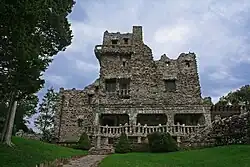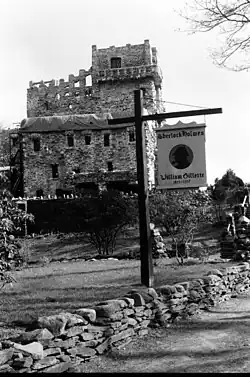Gillette Castle State Park
Gillette Castle State Park straddles the towns of East Haddam and Lyme, Connecticut in the United States, sitting high above the Connecticut River. The castle was designed and built by William Gillette (1853–1937), an American actor most famous for his portrayal of Sherlock Holmes on stage. Gillette lived here from 1919 until his death in 1937.[2] The State of Connecticut purchased the property in 1943 for $29,000.[3][4]
Seventh Sister | |
 | |
  | |
| Location | 67 River Rd., Lyme, Connecticut |
|---|---|
| Coordinates | 41°25′25″N 72°25′53″W |
| Area | 122 acres (49 ha) |
| Built | 1914 |
| Architect | Gillette, William; Porteus-Walker Co. |
| Architectural style | Bungalow/Craftsman, Medieval |
| Website | Gillette Castle State Park |
| NRHP reference No. | 86002103[1] |
| Added to NRHP | July 31, 1986 |
Location
The park is located at 67 River Road in East Haddam and consists of the castle (located in Lyme) and its grounds. It receives 350,000 annual visitors.[2] It reopened in 2002 after a four-year, $11 million restoration. It now includes a visitors' center and museum, hiking trails, and a picnic area.[5]
History
William Gillette's "castle", called Seventh Sister and renamed "Gillette Castle" by Connecticut State in 1943,[6][7] was built between 1914 and 1919 with an addition completed in 1924[8] on a 184-acre (74 ha) tract at the top of the southernmost of a chain of hills known as the Seven Sisters. Gillette died, leaving no wife or children, and his will precluded the possession of his home by any "blithering sap-head who has no conception of where he is or with what surrounded". The State of Connecticut took over the property in 1943, renaming it Gillette Castle State Park. It was added to the National Register of Historic Places in 1986.[9][10]
Gillette originally planned to build his retirement home on Long Island until he discovered the cliffs of the Seven Sisters while traversing the Connecticut River in his houseboat, "Aunt Polly".[3][4][6][11]
Gillette designed the home and personally overlooked every phase of the construction.[7] Construction was performed by the Porteus-Walker Company, a leading contracting and wood-working firm based in Hartford, Connecticut founded by Gillette's childhood friend, Robert Porteus.[10] It has been described as being designed in a medieval gothic, or an "American fairy tale mixed with European flair"[2] style, or as "a weird blending of Victorian and Arts and Crafts".[3] In the past, it had even been described as "Gillette's Folly".[4]
The 3-story-plus-tower,[10] 24-room, 14,000 sq ft home was built of wood, cement, and local Connecticut field stone, supported by a steel framework.[2][7][12][13] The exterior of the home is covered in field stone.[10] Woodwork within the home is hand-hewn southern white oak.[7][6] In some places, beams were set directly into the stones, anchored only by cement.[13] The walls, in particular, were constructed similarly to a stage set, lacking two-by-four studs and mortar in critical places.[13] It has been noted it was "a wonder the building didn't collapse" before the castle's multimillion-dollar restoration.[13] Insulation included seaweed and paper.[3] It took 20 workers from 1914 to 1919 (5 years) to complete the construction[4][7] totaling a cost of over $1 million at the time.[4] In the years Gillette lived in the home, he led and supervised thousands of refinements by local craftsmen.[7]
The style of the home's interior reflects craftsman aesthetic popularized by Gustave Stickley.[10] A number of oddities exist inside the home that were personally designed by Gillette and said to be examples of his "creative genius".[7] These include:
- 47 unique doors and door locks throughout the castle.[13] Each door is equipped with an external Steampunk-like latch intricately carved of wood.[7][6] Trick locks made unlocking these doors a puzzle.[12][13]
- Unique furnishings including built-in couches and a movable table on tracks.[6][7]
- Light switches of carved wood.[7]
- A grand upper-floor balcony running the length of the downstairs main room.[14] The walls on the second floor are notably short. This architectural feature is theorized to have been used to enhance Gillette's stature, making him appear taller to guests looking up at him from below.[3]
- A hand-carved bar, which opened with a secret latch.[13]
- A series of mirrors above the great hall allowing him to view visitors from his bedroom. This design is thought to have helped Gillette spy on guests and make dramatic entrances.[6][12][13]
- A fire suppression system[6] complete with a water tower, integrated into the home's design, that feed a unique manual fire sprinkler on the second floor overlooking the living room.
- Secret doors, passageway, and room. A secret door near the staircase leading to the rest of the home allowed Gillette to swiftly, unexpectedly, and theatrically appear to welcome or startle his guests. The secret room is only accessible by a staircase revealed after pulling down a handle. The room is small, and contains a fireplace.[12][2][6]
- A grand wooden staircase to the upper floors.[14]
The home was notably decorated with a number of Tiffany lamps made of broken bottle fragments.[13] It also had a heated bed. At one time, Gillette shared his home with up to 17 cats. For them, he designed finely crafted cat toys.[6]
Gillette was particularly fond of his 3-mile-long narrow gauge railroad with an elaborate system of switches, trestles, bridges, turnouts, and a tunnel.[10] Visitors, which reportedly included Albert Einstein, Helen Hayes, and Charlie Chaplin,[2][3] could ride the railroad around the estate and speed along the 100-foot-plus cliffs of the Connecticut River.[13] The railroad was complete with steam engine and an electric engine, and were later purchased by Lake Compounce in Bristol, Connecticut. The remaining tracks were pulled up and the roadbed converted into walking trails.[2] The engines were donated to the park in 1992, and are now on display at the Visitors' Center on the grounds.[2] Gillette's "Grand Central Station" train stop still remains[2] along with a replica on its roof of a metal cat figure.[3]
The grounds also contained a root cellar, walking paths with near-vertical steps, a two-story gable-ended vernacular dwelling for servants, a small period barn, stone-arch bridges, wooded trestles spanning up to 40 ft (12 m), and fish pond.[7][10]
Image gallery
_AM_1504_Vibrant.jpg.webp)
 View from the Connecticut River.
View from the Connecticut River. Gillete Caste from the Connecticut River overlook
Gillete Caste from the Connecticut River overlook Side view of the castle.
Side view of the castle. Ruins of stone bridge designed by Gillette.(Low Resolution)
Ruins of stone bridge designed by Gillette.(Low Resolution)

 Library, interior of the castle.
Library, interior of the castle. Connecticut River, a view from Castle.
Connecticut River, a view from Castle. Connecticut River as seen from the overlook behind the Castle
Connecticut River as seen from the overlook behind the Castle
See also
References
- "National Register Information System". National Register of Historic Places. National Park Service. March 13, 2009.
- Cody, Sarah. "Exploring Gillette Castle". ctnow.com. Retrieved September 26, 2017.
- Woodside, Christine (June 2, 2002). "A Castle Restored, Including the Quirks". The New York Times. ISSN 0362-4331. Retrieved September 26, 2017.
- "William Gillette: King Of His Castle". tribunedigital-thecourant. Retrieved September 26, 2017.
- Protection, Department of Environmental. "DEEP: Gillette Castle State Park". www.ct.gov. Retrieved September 26, 2017.
- Ofgang, Erik. "Gillette Castle, Once Home of 'Sherlock Holmes', Opens Season of Tours". Connecticut Magazine. Retrieved September 26, 2017.
- Walker, T. "Gillette Castle State Park, a Connecticut park located near Clinton, Colchester and Cromwell". www.stateparks.com. Retrieved September 26, 2017.
- "Gillette Castle State Park". Department of Energy and Environmental Protection. State of Connecticut. Retrieved May 25, 2016.
- "Seventh Sister". National Register Digital Assets. National Park Service. Retrieved May 25, 2016.
- "National Register of Historic Places Inventory Nomination Form". Archived from the original on September 27, 2017. Retrieved September 26, 2017.
- "Aunt Polly and Its Preservation | ConnecticutHistory.org". connecticuthistory.org. Retrieved September 26, 2017.
- "Holmes at Home: The Life of William Gillette | ConnecticutHistory.org". connecticuthistory.org. Retrieved September 26, 2017.
- LEFF, DAVID K. "William Gillette's Ghost Revived At His Castle". courant.com. Retrieved September 26, 2017.
- Webmaster. "Gillette Castle – Gillette Castle State Park East Haddam Connecticut Photos William Gillette's Sherlock Holmes". www.ctrivervalley.com. Retrieved September 26, 2017.
External links
- Gillette Castle State Park by the Connecticut Department of Energy and Environmental Protection
- Friends of Gillette Castle State Park
- Gillette Castle State Park by CTRiverValley.com
- Gillette Castle by All Things Medieval